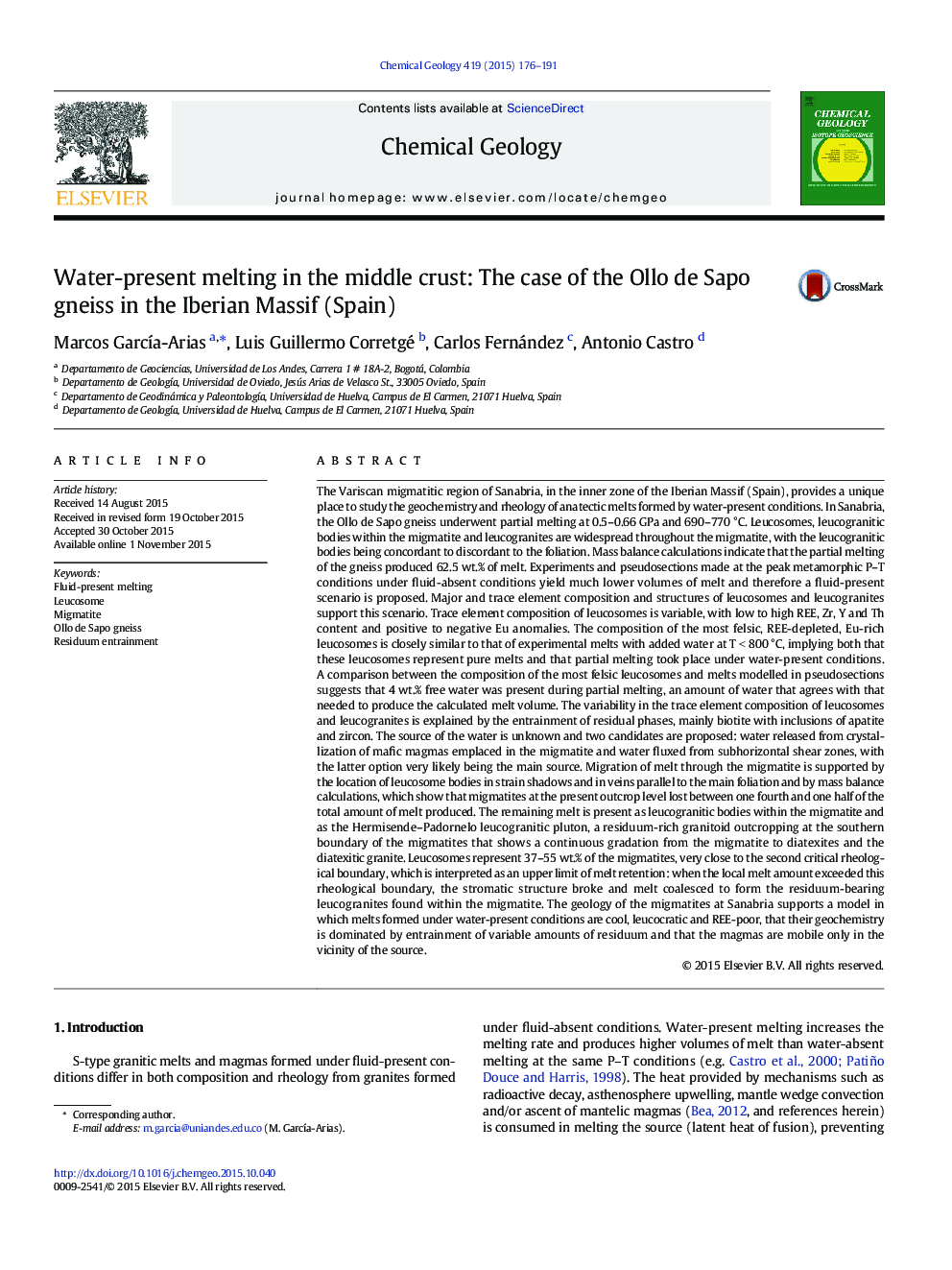| کد مقاله | کد نشریه | سال انتشار | مقاله انگلیسی | نسخه تمام متن |
|---|---|---|---|---|
| 4698411 | 1637555 | 2015 | 16 صفحه PDF | دانلود رایگان |

• 62 wt.% melt was produced in the migmatitic region of Sanabria at temperatures below biotite breakdown.
• Melt volume and major and trace element composition of leucosomes require melting under water-present conditions.
• Melt migrated within the migmatite, breaking down locally the stromatic structure and producing leucogranites.
• Leucosomes and leucogranites contain some amounts of entrained accessory-rich biotite.
The Variscan migmatitic region of Sanabria, in the inner zone of the Iberian Massif (Spain), provides a unique place to study the geochemistry and rheology of anatectic melts formed by water-present conditions. In Sanabria, the Ollo de Sapo gneiss underwent partial melting at 0.5–0.66 GPa and 690–770 °C. Leucosomes, leucogranitic bodies within the migmatite and leucogranites are widespread throughout the migmatite, with the leucogranitic bodies being concordant to discordant to the foliation. Mass balance calculations indicate that the partial melting of the gneiss produced 62.5 wt.% of melt. Experiments and pseudosections made at the peak metamorphic P–T conditions under fluid-absent conditions yield much lower volumes of melt and therefore a fluid-present scenario is proposed. Major and trace element composition and structures of leucosomes and leucogranites support this scenario. Trace element composition of leucosomes is variable, with low to high REE, Zr, Y and Th content and positive to negative Eu anomalies. The composition of the most felsic, REE-depleted, Eu-rich leucosomes is closely similar to that of experimental melts with added water at T < 800 °C, implying both that these leucosomes represent pure melts and that partial melting took place under water-present conditions. A comparison between the composition of the most felsic leucosomes and melts modelled in pseudosections suggests that 4 wt.% free water was present during partial melting, an amount of water that agrees with that needed to produce the calculated melt volume. The variability in the trace element composition of leucosomes and leucogranites is explained by the entrainment of residual phases, mainly biotite with inclusions of apatite and zircon. The source of the water is unknown and two candidates are proposed: water released from crystallization of mafic magmas emplaced in the migmatite and water fluxed from subhorizontal shear zones, with the latter option very likely being the main source. Migration of melt through the migmatite is supported by the location of leucosome bodies in strain shadows and in veins parallel to the main foliation and by mass balance calculations, which show that migmatites at the present outcrop level lost between one fourth and one half of the total amount of melt produced. The remaining melt is present as leucogranitic bodies within the migmatite and as the Hermisende–Padornelo leucogranitic pluton, a residuum-rich granitoid outcropping at the southern boundary of the migmatites that shows a continuous gradation from the migmatite to diatexites and the diatexitic granite. Leucosomes represent 37–55 wt.% of the migmatites, very close to the second critical rheological boundary, which is interpreted as an upper limit of melt retention: when the local melt amount exceeded this rheological boundary, the stromatic structure broke and melt coalesced to form the residuum-bearing leucogranites found within the migmatite. The geology of the migmatites at Sanabria supports a model in which melts formed under water-present conditions are cool, leucocratic and REE-poor, that their geochemistry is dominated by entrainment of variable amounts of residuum and that the magmas are mobile only in the vicinity of the source.
Journal: Chemical Geology - Volume 419, 25 December 2015, Pages 176–191